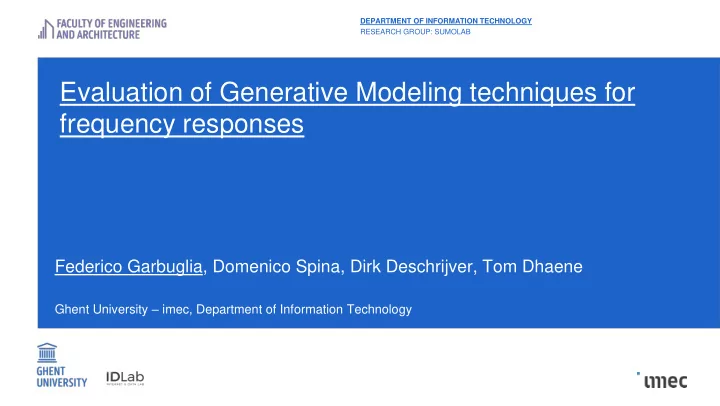

DEPARTMENT OF INFORMATION TECHNOLOGY RESEARCH GROUP: SUMOLAB Evaluation of Generative Modeling techniques for frequency responses Federico Garbuglia, Domenico Spina, Dirk Deschrijver, Tom Dhaene Ghent University – imec, Department of Information Technology
Outline • Introduction • Methodology • Results • Conclusion 2
Introduction 3
̶ ̶ Introduction Performance of modern RF and Microwave circuits is largely affected by manufacturing tolerances A device frequency response is usually subject to high variability with respect to design parameters → Uncertainty quantification is often required 4
̶ ̶ Introduction Uncertainty quantification requires many statistical samples, i.e. frequency responses, which are expensive to obtain → Use of Generative Modeling techniques The idea behind Generative Modeling 1) Simulate or measure few frequency responses (training instances) 2) Train a model to produce new responses, according to a statistical distribution that matches the original one 3) Generate many new responses for uncertainty quantification 5
Methodology 6
̶ ̶ Methodology In this work: • Two generative algorithms: Gaussian Process-Latent Variable Model ( GP-LVM ) Variational Autoencoder ( VAE ) • Both algorithms adopt a generative framework based on Vector Fitting ( VF ) [1] Advantages 1. Black-box approach 2. No knowledge of the number of varying parameter or their distribution 3. Stability and reciprocity of frequency responses guaranteed by VF characterization 7
̶ ̶ Methodology Proposed Modeling Framework [1] Steps 1. Training data are converted from S-parameters to rational coefficients via VF 2. The generative model (GP-LVM or VAE) is trained on the rational coefficients 3. New rational instances are generated by the model 4. Rational instances are reconverted in S-parameters 5. Non-passive instances are discarded 8
̶ ̶ ̶ Vector Fitting Converts S-parameters responses 𝐓(𝑡) into a rational model [2] 𝒔 𝑗 : 𝑠𝑓𝑡𝑗𝑒𝑣𝑓𝑡 𝑏 𝑗 : 𝑞𝑝𝑚𝑓𝑡, 𝑑𝑝𝑛𝑛𝑝𝑜 𝑢𝑝 𝑏𝑚𝑚 𝑗𝑜𝑡𝑢𝑏𝑜𝑑𝑓 𝑡: 𝑑𝑝𝑛𝑞𝑚𝑓𝑦 𝑔𝑠𝑓𝑟𝑣𝑓𝑜𝑑𝑧 𝑤𝑏𝑠𝑗𝑏𝑐𝑚𝑓 Only residues 𝒔 𝑗 are fed into the GP-LVM or VAE S-parameters are reconstructed by evaluating the rational model at the desired frequency 𝑡 9
̶ ̶ ̶ Generative Models Generative models reproduce the distribution of observed residues data 𝑞(𝑍) , given a distribution of latent variables 𝑞 𝑌 • 𝑌 variables encode the sources of variability, without an explicit relation to the design parameters 𝑞 𝑍 is obtained by marginalizing 𝑞 𝑍, 𝑌 = 𝑞 𝑍 𝑌 𝑞(𝑌) 𝑞 𝑌 is Gaussian by assumption in both GP-LVM and VAE: 𝑞 𝑌 = 𝑂 𝑷, 𝑱 10
̶ ̶ Gaussian Process-Latent Variable Model The GP-LVM [3] maps the latent space to the observed space using Gaussian Processes (GPs), modeling the likelihood 𝑞 𝑍 𝑌 Σ: 𝑑ℎ𝑝𝑡𝑓𝑜 𝑙𝑓𝑠𝑜𝑓𝑚 𝑛𝑏𝑢𝑠𝑗𝑦 𝑧 𝑒 : 𝑝𝑐𝑡𝑓𝑠𝑤𝑏𝑢𝑗𝑝𝑜𝑡 𝑝𝑔 𝑢ℎ𝑓 𝑒 𝑢ℎ 𝑠𝑓𝑡𝑗𝑒𝑣𝑓 A new instance of residues 𝑍 ∗ is generated by drawing a sample 𝑌 ∗ from 𝑞 𝑌 and evaluating the corresponding GPs output 11
̶ ̶ ̶ Variational Autoencoder The VAE [4] learns 𝑞 𝑍 𝑌 likelihood and 𝑞 𝑌 𝑍 posterior at the same time, by maximizing a variational lower bound It maps the latent space to the observed space using a neural architecture: Like in GP-LVM, a new instance of residues 𝑍 ∗ is generated by drawing a sample 𝑌 ∗ from 𝑞 𝑌 and evaluating the output of the decoder network 12
̶ Accuracy Metric Cramer-Von-Mises statistics [5] is employed: • It compares 1. the original distribution from a validation set of responses 2. the distribution of a set of generated responses • The two sets can have different cardinality • It provides a dissimilarity score ( CM-score ) across the frequency range • Lower CM-score means higher accuracy of the model 13
Results 14
̶ ̶ Example 1 : Microstrip coupled transmission lines Avg. CM score Settings: • 5 design parameters, 2 ports, range [0-1.8] GHz • 10% standard deviation from nominal value • 50 training instances Results: • High accuracy for both GP-LVM and VAE • GP-LVM more accurate on average 15
Example 1 : Generated Distributions 16
Example 1 : Microstrip coupled transmission lines S 11 Smith Chart (detail), for 50 frequency responses GPLVM generated responses VAE generated responses Training responses +j0.5 +j1 +j0.5 +j1 +j0.5 +j1 -j0.5 -j1 -j0.5 -j1 -j0.5 -j1 17
Example 1 : Microstrip coupled transmission lines S 11 residues pairs in the complex plane, for 50 frequency responses Training responses GPLVM generated responses VAE generated responses 18
̶ ̶ Example 2 : Microstrip stop-band filter Avg. CM score Settings: • 4 design parameters, 2 ports, range: [5-25 GHz] • 5% standard deviation from nominal value • 100 training instances Results: • wide-band and highly variable frequency response: → lower accuracy than in Example 1 • VAE more accurate on average 19
Conclusions 20
̶ ̶ ̶ Conclusions The VF-based generative modeling framework can produce many frequency responses from a small set of data Two generative models, the GP-LVM and the VAE are tested on two application examples Both models show adequate performance and can reduce the computational load for uncertainty quantification purposes 21
References [1] De Ridder, S. Deschrijver, D. Manfredi, P. Dhaene, T. Vande Ginste, D. Generation of Stochastic Interconnect Responses via Gaussian Process Latent Variable Models. IEEE Trans. Electromagn. Compat. 2018 , 61 , 582 – 585 [2] Gustavsen, B. Semlyen, A. Rational approximation of frequency domain responses by vector fitting. IEEE Trans. Power Del. 1999 , 14 , 1052 – 1061. [3] Titsias, M. Lawrence, N. D. Bayesian Gaussian process latent variable model. Proc. 13th Int. Conf. Artif. Intell. Statist. 2010 , 844-851.[Online] [4] Ma, X. Raginsky, M. Cangellaris, A.C. A Machine Learning Methodology for Inferring Network S-parameters in the Presence of Variability. Proc. IEEE 22nd Workshop Signal Power Integr. (SPI), Brest, France 2018 . [5] Anderson, T.W. On the distribution of the two-sample Cramer-von Mises criterion Ann. Math. Statist. 1962 , 33 , 1148 – 1159 22
Federico Garbuglia PhD Researcher Ghent University - imec, IDLab iGent Tower - Department of Information Technology Technologiepark-Zwijnaarde 15, B-9052 Ghent Belgium E: federico.garbug@ugent.be W: http://IDLab.UGent.be
Recommend
More recommend